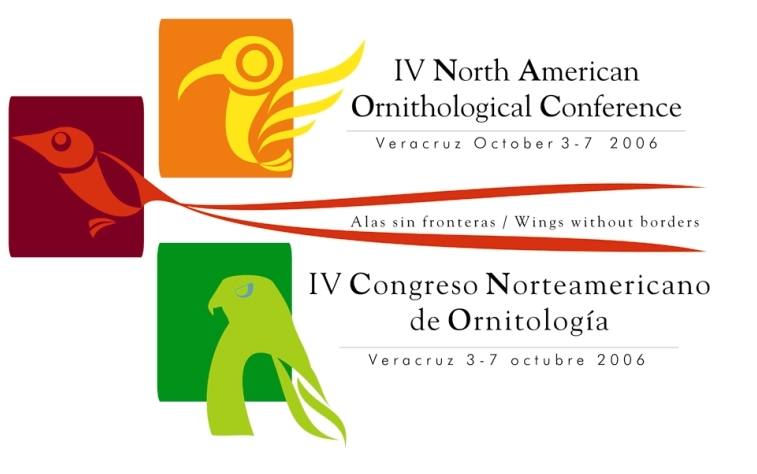
.
At the largest professional
meeting of its kind in North America, seven Powdermill Avian Research Center
staff and interns were among the >1,700 participants of the IV North American
Ornithological Conference in Mexico earlier this month. Below we
share some of the highlights (and photos) from this very productive trip!
.

-
The NAOC conference was conveniently scheduled in Veracruz,
Mexico at the time when millions of raptors converge during migration and
funnel through where the mountains meet the Gulf of Mexico on the east
coast. Many on their journey to their wintering grounds in South
America had come from even farther north than those of us at Powdermill
in southwestern PA. So, it seemed purposeful and fitting that at
this same time, ornithologists from around North America converged to share
research and avian conservation initiatives via plenary lectures, organized
symposia, oral presentations, and poster sessions, as well as, diverse
social programs. In the photo below, conference participants view
posters during an informal break between some of the oral presentations.

-
As mentioned above, among the presenters were seven staff
and interns from the Powdermill Avian Research Center. Without a
doubt, PARC's contribution to the scientific program was substantial and
diverse, covering topics on the Louisiana Waterthrush as a bioindicator,
analyses of bioacoustical data collected at Powdermill, GIS and its use
in assessing and developing bird habitat assoctiation models, the results
from the first three years of the 2nd Pennsylvania Breeding Bird Atlas,
and boreal bird communities at migration banding stations.
-
While there were meetings and workshops on the days prior
to and following the conference, Wednesday, October 4 was the first full
day of lectures and the first poster session. That afternoon, Mike
Lanzone (Asst. Field Ornithology Projects Coordinator at PARC) gave an
oral presentation on A New Method for Recording Flight
Call Notes from Passerines (slideshow and audio for this presentation
will be uploaded shortly). That night during the poster session,
which is an opportunity for conference attendees to walk around and discuss
posters with the authors, three of PARC staff presented. Each of
the following poster titles are linked to full image pdf versions.
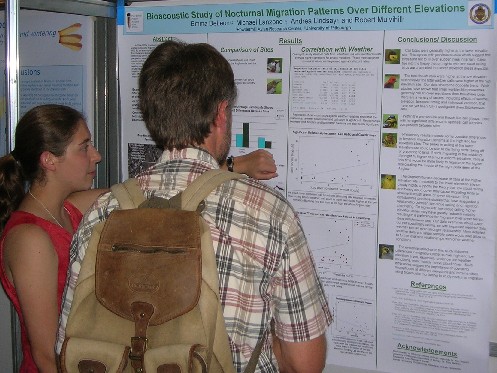
Emma DeLeon (PARC Bioacoustic Technician)
discusses the results of her research on Nocturnal
Migration Patterns at High and Low Elevation Sites in the Mid-Appalachians
Based on Bioacoustical Monitoring with
a conference attendee.
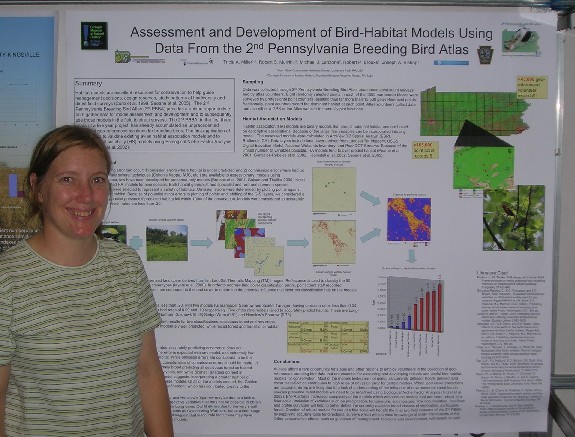
Trish Miller (Powdermill GIS Manager) with
her poster from her graduate research on Assessment
and Development of Bird-Habitat Association Models Using Data from the
2nd Pennsylvania Breeding Bird Atlas.

Felicity Newell (PARC Research Assistant) happily
discusses the results of her work on The
Impacts of Stream Acidification on Louisiana Waterthrush Breeding Biology:
A Long-Term Study with a fellow waterthrush
researcher.
-
Thursday provided us another opportunity
to attend many interesting oral presentations throughout the day and that
night some of us attended an informative and educational social hosted
by the Boreal Songbird Initiative and Internatinal Migratory Bird Day.
It was a fun and inspriring evening followed Friday morning by a symposium
on The Boreal Birds: Threads that Tie Together America's Ecosystem.
Jeff Wells, Senior Scientist for the Boreal Songbird Initiative, organized
and hosted the symposium (to read his blog on the meeting, click
here ), during which PARC Bander-in-Charge, Adrienne Leppold, presented
Boreal
Bird Communities at Migration Banding Stations: Banding as a means for
effective monitoring (slideshow and audio
for this presentation also will be uploaded shortly).


-
Friday night, during the second of the two poster sessions,
PARC staff and research was again well represented.
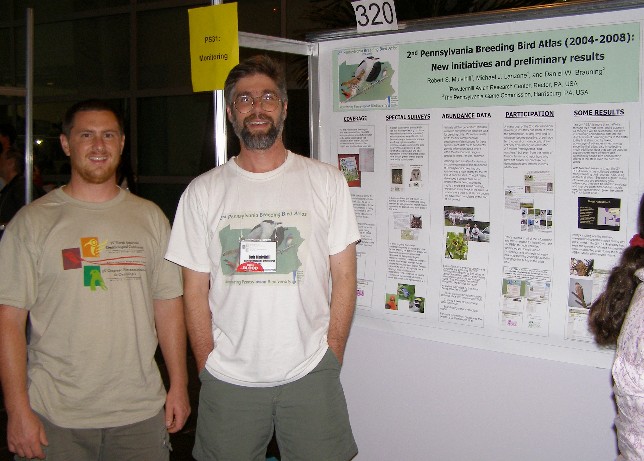
Bob Mulvihill (PARC
Field Ornithology Projects Coordinator) poses with assistant Mike Lanzone
at his poster reporting an Overview
of the 2nd Pennsylvania Breeding Bird Atlas (2004-2008): New Initiatives
and Preliminary Results.
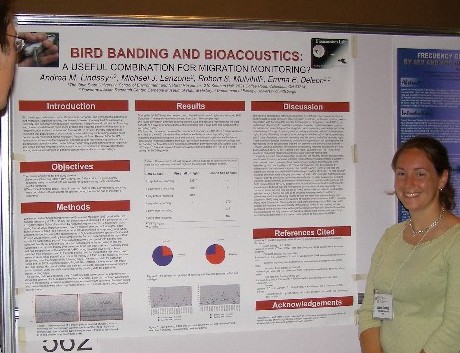
Annie Lindsay (Fall 2005 PARC Bioacoustics
Intern) with her poster on Bird
Banding and Bioacoustics: A Useful Combination for Migration Monitoring?
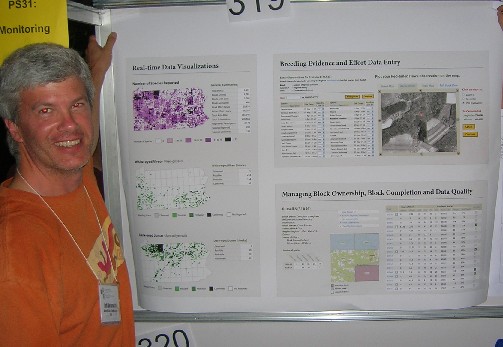
Jeff Gerbracht (Application Developer for Cornell
Lab of Ornithology) presented his work with Chris Wood (Cornell Lab of
Ornithology, eBird Project Manager)
on Conducting a Breeding Bird Atlas in the 21st Century.
Jeff and Chris collectively developed an online
method for atlas data submission and summarization. Pennsylvania's
2nd Breeding Bird Atlas (coordinated by Bob Mulvihill and Mike Lanzone
at PARC) was the first state to use this technology and examples of data
submission and mapping capabilities for PA were featured on Jeff's poster.

-
We also appreciate George Farnsworth's
(professor at Xavier University in Ohio, photo from lab) contribution to
the conference in presenting his models for Estimating
Breeding Bird Abundances with Point Counts from the 2nd Pennsylvania Breeding
Bird Atlas, which was based on sophisticated
statistical analyses of results of more than 10,000 point counts conducted
for the 2nd PBBA.
In closing, a full day of oral
presentations and a banquet dinner Saturday night wrapped up a very successful
and productive (and tiring!) conference for us all, with many new opportunities
and collaborations resulting from this meeting. Specifically, we
were recruited into the Rusty Blackbird working group and will begin to
identify migration banding stations that are well situated to monitor this
species, for which we will develop a protocol for capture and data collection
methods. In addition, we look forward to developing further a collaboration
with Dr. David Evers from the Biodiversity Research Institute to focus
efforts on the Louisiana Waterthrush as an indicator of the presence and
effects of mercury in birds in the NE.
-
With the conference over and all
of our hard work out of the way, we took a couple days to enjoy the flora
and fauna (avifauna in particular) of Mexico before returning to our many
projects back at Powdermill.


Aztec Parakeets, La Mancha
-
As mentioned above, the spectacular hawk migration played
a major role in the timing and location of the conference, so, luckily,
Sunday we were able to witness the largest movement of birds during the
entire trip. Over 350,000 migrating raptors were tallied collectively
from the hawk watch on the roof of our hotel in Cardel and the second hawk
watch site in Chichicaxtle just 10 miles away from Cardel. There
are nearly no words to describe seeing the migration of over 1/4 million
raptors in the single day span of a just a few hours. It really was
a river of raptors that spanned the sky for as far as the eye could see.
WOW!!!

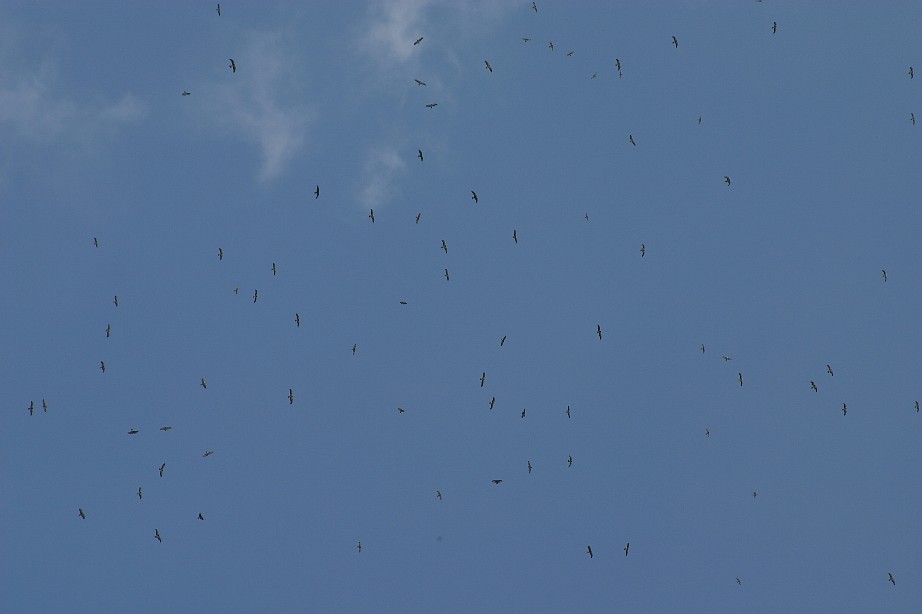
-
The kettles and "rios de rapaces" observed during our
trip were principally of Turkey Vultures, Swainson's Hawks, and Broad-winged
Hawks (both light and dark color phases). Additionally, many other
birds were observed regularly with the large movements of hawks, and some
of these were also often seen in large flocks: Wood Stork, White Pelican,
Anhinga, Peregrine Falcon, Cooper's Hawk, Mississippi Kite, Zone-tailed
Hawk, Black Hawk and Short-tailed Hawk (the latter two were often observed
soaring much lower than the large migrating flocks and were likely local
birds). For more information on Hawk Migration in Veracruz please
visit the Pronatura Veracruz website at http://www.pronaturaveracruz.org
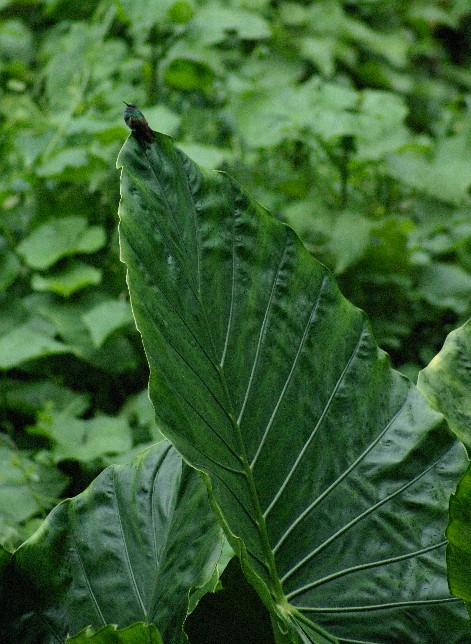
Berylline Hummingbird atop large leaf in Macuiltepetl, Xalapa
-
Finally, we thank all those at Powdermill who helped make
our trip possible, especially our banding/ringing team of Bob Leberman
(PARC senior bird bander emeritus), David Norman (ringing friend and research
associate from Great Britain), Chris Benson (a new ringing colleague form
Ireland), Scott Kennedy (ringing colleague from England), and Deb Plotts
(bander friend from Ohio) for filling our shoes while we were gone and
holding down the banding fort during a very busy time of year (and
what proved to be the busiest banding day in the 45 year history of the
program). Many, many thanks are also due Kristin Sesser for her
very capable and patient late night printing of all of our posters for
the conference and also for the many GIS maps she generated and provided
for Adrienne's boreal bird presentation (some of which were even sent via
email to Mexico).
.
< Home >
Last Updated on 10/20/06
By Adrienne J. Leppold.

